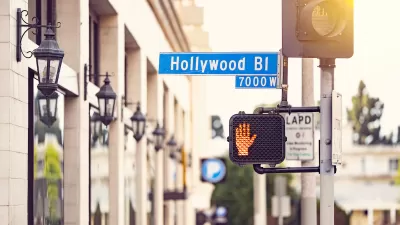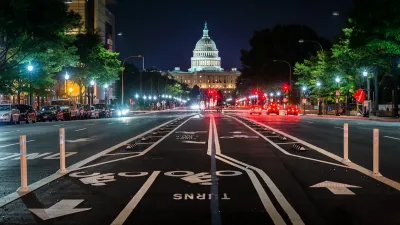In car-dependent communities, road diets and bike lanes can be a tough sell.

A status quo bias mixed with car dependence can make it hard for communities to eliminate traffic lanes. For a CityLab article, Matt Tinoco shares details of a Pasadena planning meeting, which reviewed a proposal to turn two of four lanes into two lanes: a turn lane and a bike lane. "Shedding lanes, one said, would be an 'unmitigated traffic disaster.' Not only would residents who live along the road never again be able to back out of their driveways, bicycle accidents would increase (because the new lanes would attract more riders)." One official asked for supporters to yell out their support or opposition to the diet, the voices of those opposed were louder. The second hearing on the plan was cancelled in the face of its opposition.
"Such redesigns may be popular with traffic safety advocates—lane reductions have been shown to reduce the total number of crashes by up to 47 percent, according to the Federal Highway Administration," says Tinoco.
Still, anticipated push-back can kill these efforts before they even come to the public. In Los Angeles, officials have been so chastened after the failure of a few road diets (the first of many that had been planned) that they've moved to smaller activations. "Instead of lane reductions, they’re opting for less-aggressive street treatments, like adding signalized crosswalks, dedicated left-turn pockets, and intersection tightening," Tinoco writes
FULL STORY: How to Kill a Bike Lane

Alabama: Trump Terminates Settlements for Black Communities Harmed By Raw Sewage
Trump deemed the landmark civil rights agreement “illegal DEI and environmental justice policy.”

Planetizen Federal Action Tracker
A weekly monitor of how Trump’s orders and actions are impacting planners and planning in America.

The 120 Year Old Tiny Home Villages That Sheltered San Francisco’s Earthquake Refugees
More than a century ago, San Francisco mobilized to house thousands of residents displaced by the 1906 earthquake. Could their strategy offer a model for the present?

In Both Crashes and Crime, Public Transportation is Far Safer than Driving
Contrary to popular assumptions, public transportation has far lower crash and crime rates than automobile travel. For safer communities, improve and encourage transit travel.

Report: Zoning Reforms Should Complement Nashville’s Ambitious Transit Plan
Without reform, restrictive zoning codes will limit the impact of the city’s planned transit expansion and could exclude some of the residents who depend on transit the most.

Judge Orders Release of Frozen IRA, IIJA Funding
The decision is a victory for environmental groups who charged that freezing funds for critical infrastructure and disaster response programs caused “real and irreparable harm” to communities.
Urban Design for Planners 1: Software Tools
This six-course series explores essential urban design concepts using open source software and equips planners with the tools they need to participate fully in the urban design process.
Planning for Universal Design
Learn the tools for implementing Universal Design in planning regulations.
Clanton & Associates, Inc.
Jessamine County Fiscal Court
Institute for Housing and Urban Development Studies (IHS)
City of Grandview
Harvard GSD Executive Education
Toledo-Lucas County Plan Commissions
Salt Lake City
NYU Wagner Graduate School of Public Service





























